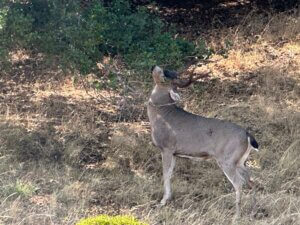
Aw nuts—it’s acorn season
Understanding the importance of autumn’s leading food source in our forests

You’re on a walk through the oak-and-bay woods at China Camp, when suddenly the branches above you get whipped into a frenzy. Limbs twist and leaves float down. You spy a gray squirrel clambering through the branches overhead, with a spray of acorns on a twig gripped in the squirrel’s mouth. You walk a little further along the trail when, up on the slope above you, you hear frenzied scuffing on the forest floor, and see a flock of turkeys raking the ground with their spidery feet, searching for acorns. Around a bend, a deer bounds across the trail, then stops and turns, chewing as it surveys you from the shadows. In its mouth? You guessed it: acorns.
It’s busy busy busy out there at China Camp in autumn, as one of the park’s most important food sources ripens and falls. It’s the season of acorns, most notably the nuts of California live oaks. These acorns provide carbohydrate-rich food for a vast array of wildlife in the park—from scrub jays and squirrels to mice and mule deer, and even foxes and coyotes. When Coast Miwok tribes lived in the area now known as China Camp, acorns may have made up as much as half of the Native Americans’ diet, report researchers from UC Berkeley.
Coast live oak aren’t the only oaks in our park that produce acorns. The park’s deciduous valley oaks, which shade the Turtle Back Nature Trail and dot Back Ranch Meadows, as well as the shrubby scrub oak, also produce acorns. But it’s the coast live oak which takes the prize as the number-one nut producer in our autumn forest.
Acorns and the feisty bird that goes “waka-waka”
While a wide range of creatures munch acorns this time of year, one of the most entertaining—and easy to spot—is the aptly named acorn woodpecker. This energetic, black-and-white bird is about the size of a small, chubby jay, with a crimson cap and a jaunty white eye ring that gives the woodpecker a clownish air. These extremely social birds eat mature acorns directly off the trees, and it’s common to spot them giving their raucous “waka-waka” call as they fly from branch to branch, gathering nuts.

But acorn woodpeckers don’t eat all the nuts they harvest. They also stash them, but in a very specific way. Clasping a ripe acorn in their beaks, birds head to a local “granary tree,” where they insert the acorns into holes they’ve drilled into the bark. Thousands of these drill holes, stuffed with acorns, pock the bark of granary trees (and sometimes wooden telephone poles), with some reports counting upwards of 50,000 acorns stored in a single tree. Such a stash can provide an important source of food when acorn season ends.
These woodpeckers don’t just store their acorns and scoot. In fact, they take care of their hoard, turning acorns regularly so they dry evenly and don’t rot. If an acorn shrinks and loosens in its storage hole, a woodpecker may move it to a snugger spot. And these feisty birds also protect their granaries from thieves like squirrels, scrub jays, and even other bands of marauding acorn woodpeckers.
Another bird that plays a big role during acorn season is the jay. Though China Camp has mainly scrub jays, deep-woods-loving Steller’s jays also frequent the park. During acorn season, jays are known to nab a ripe acorn, then whisk it off to a secret spot—perhaps a damp and shady patch of soil—then gently tap it into the ground. Jays then cover the buried nut with some leafy duff, and fly off to repeat the process. Researchers have found that jays can be incredibly speedy at this task, burying one acorn every 28 seconds. That’s a lot of acorns, and though these intelligent birds have been shown to remember a remarkable number of locations where they have buried their acorns and return to eat them later, some nuts simply sprout. So we like to think of jays as oak-tree farmers, bringing a new crop of trees into the world.
With woodpeckers, jays, and so many other animals reliant on acorns for food, it’s especially worrisome when something threatens the health of coast live oak trees. That’s one of the reasons why sudden oak death (SOD), which has wiped out a huge number of our coast live oaks in the park, is so worrisome. While there is no cure for the disease, researchers have found that some live oak trees appear to be more resistant to the pathogen that causes SOD. Hopefully, this natural resistance means enough coast live oaks will survive, providing acorn crops for all our animals, and meaning we’ll hear the waka-waka of acorn woodpeckers and squawk of jays for years to come.
—by Harriot Manley/FOCC volunteer
ARTICLE: More on sudden oak death at China Camp
VIDEO: Woodpeckers: the whole story

